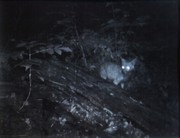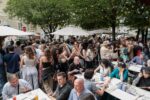Emiliano Maggi – Argenti Dominus Vulpes

In occasione della chiusura della mostra Fà un po’ freddo ma non preoccuparti all’interno di Brown Project Space, l’intervento scultoreo di Fabrizio Prevedello svilupperà il suo percorso ospitando e confrontandosi con l’immaginario di Emiliano Maggi. Nello spazio cavo della scultura, nel nucleo protetto, Emiliano infatti metterà in scena la sua performance Argenti Dominus Vulpes.
Comunicato stampa
La Pratica dell’Immaginazione
In occasione della chiusura della mostra Fà un po’ freddo ma non preoccuparti all’interno di Brown Project Space, l’intervento scultoreo di Fabrizio Prevedello svilupperà il suo percorso ospitando e confrontandosi con l’immaginario di Emiliano Maggi. Nello spazio cavo della scultura, nel nucleo protetto, Emiliano infatti metterà in scena la sua performance Argenti Dominus Vulpes.
Considerando il rituale un atto, o un insieme di atti, eseguito secondo norme codificate per poter essere ripetibile, il rito è proprio l’elemento che accomuna entrambi i lavori e le rispettive pratiche artistiche dei loro creatori.
Emiliano Maggi nella sua performance ci mostrerà l’aspetto del rito legato alla trasmissione orale, il codificare cioè il sapere in un racconto, in una favola, per poterlo poi condividere, come nel teatro popolare, attraverso suoni, canti, costumi e coreografia. Tutti questi elementi che andranno a comporre la rappresentazione nascono dal mondo naturale e soprattutto dal mondo animale, scelti per narrare una fiaba sul corteggiamento amoroso e la lotta di due animali, e per mostrare il lato istintivo, naturale e puro dell’essere umano. Emiliano cercherà quindi di mantenere in vita un folklore, una storia antica ed una pratica recitativa vicina a quella degli sciamani, che, attraverso il mascheramento, sono alla ricerca di una possessione finalizzata alla narrazione.
Fabrizio Prevedello invece nella sua scultura ha ritualizzato lo sforzo fisico e mentale che lo accompagna sempre nella sua tecnica artistica. Sforzo che nasce sia dal lavoro dello scultore nel misurarsi con la materia, sia dalla sfida derivata dall’accostarsi all’elemento naturale, sia dallo scegliere spesso la montagna o come luogo o come soggetto dei suoi lavori. Questo impegno derivato dal suo processo creativo è quindi condiviso e richiesto anche a chi volesse visitare la sua scultura. Per accedervi infatti bisogna superare un arco d’ingresso composto in lastre grezze d’ardesia, scure e taglienti, che si trova posizionato al di sopra di uno scalino sovradimensionato. Quindi anche il fruitore deve compiere un sacrificio rituale per entrare e successivamente oltrepassare un cammino iniziatico per poter esperire a pieno il lavoro.
L’opera di Fabrizio, nata con appunto il desiderio di creare uno spazio riparato, un rifugio, diverrà quindi un vero e proprio teatro per uno spettacolo fruibile da un numero limitato di persone. Essendosi sviluppata come un prototipo non finito di bivacco, ospitare è sempre stato il suo obiettivo principale. Per vedere e fruire la scultura bisogna infatti entrare al suo interno, dove lo spettatore può effettivamente esperire l’opera attraverso un cammino suddiviso in più tappe: l’ingresso, la scoperta del nucleo e dei successivi indizi che Fabrizio ha lasciato sotto forma di oggetti, ed infine lo sviluppare le incognite nate da questi appunti in relazione agli altri elementi che compongono tutta la struttura.
Perciò necessariamente la scultura accoglie lo spettatore al suo interno, lo protegge e gli permette di immaginare. La fruizione diventa quindi attiva, lo spettatore diventa parte della struttura e protagonista di una propria rappresentazione interiore.
Con l’intervento di Emiliano Maggi questo percorso dello spettatore, sia fisico che immaginativo, ha la possibilità di svilupparsi ulteriormente: dopo essere diventato attore di questo spettacolo scultoreo, il fruitore ha ora la possibilità di compiere un ulteriore passo; andare avanti, superare le pareti invisibili della struttura e ridiscendere dal palco per tornare ad essere nuovamente spettatore sia di questa messa in scena scultorea vista ora nella sua interezza, sia del nuovo spettacolo che sta per incominciare.
Viene lasciato lo spazio al lavoro performativo di Emiliano, che potrà così inserirsi nel paesaggio non finito creato da Fabrizio, cercando di dare maggiori stimoli evocativi agli spettatori per aiutarli ad immaginare. Anche lui cercherà di completare le incognite lasciate in sospeso costruendo attraverso il suo immaginario, il suo racconto e la sua musica le parti non finite della scultura. Riempirà le pareti di immagini e trasformerà il piano rialzato della struttura in un vero e proprio altare dove poter compiere il proprio rituale condiviso.
All’interno quindi di quel luogo creato per dare appunto spazio “ai nostri pensieri e rituali, ” come lo ha definito Fabrizio, Emiliano avrà la possibilità di dimostrarci come sia importante mantenere in vita la pratica dell’immaginazione.
Davide Daninos
The Practice of Imagination
For the closing of the Fà un po’ freddo ma non preoccuparti exhibition in Brown Project Space, the Fabrizio Prevedello’s sculptural intervention will develop its path by hosting and facing the imaginary of Emiliano Maggi. In the hollow space of the sculpture, in the protected core, Emiliano in fact will stage its performance Argenti Dominus Vulpes.
Considering the ritual an act, or a series of acts, performed according to rules encoded in order to be repeatable, the rite is exactly the element that links both works and the respective artistic practices of their creators.
Emiliano Maggi in his performance will show the ritual aspect linked to oral transmission, that is the encoding a knowledge in a story, a fairy tale, then to be able to share it, as in the popular theater, through sounds, songs, costumes and choreography. All these elements, that will make up the representation, arise from the natural world and above all from the animal world, chosen to tell a fable about the courtship and the fight of two animals, and to demonstrate the instinctive, natural and pure side of being human.
Emiliano will seek to keep alive a folklore, an ancient story and a recitative practice close to the shamans, that, through the masking, are looking for a possession aimed at narration.
Fabrizio Prevedello instead has ritualized in his sculpture the physical and mental effort that always accompanies him during his artistic technique. Effort that is born either from the work of the sculptor in measuring the matter, either from the challenge derived from the approaching the natural element, either from choosing often the mountain as the location or as the subject of his works. This struggle resulting from his creative process is then shared and asked also to those would visit the sculpture. In fact the access needs a walk trough an entry arch, composed in raw slabs of slate, dark and sharp, which is placed on top of an oversize step. Therefore also the viewer must make a ritual sacrifice to enter and later he has to go beyond an initiatory path to experiencing the full work.
The work of Fabrizio, born exactly with the desire to create a sheltered space, a refuge, so becomes a real theater for a show accessible by a limited number of people. Being developed as an unfinished prototype of a bivouac, hosting has always been its main objective. To see and benefit from the sculpture you should in fact go inside, where the audience can actually experiencing the work through a process divided into several steps: the entry, the discovery of the core and the subsequent evidence that Fabrizio has left in shape of objects, and finally the development of the unknowns factors raised from these notes in relation to other elements that compose the whole structure.
So the sculpture necessarily accepts the viewer inside, it protects him and allows him to imagine. Thus the fruition becomes active, the observer becomes part of the structure and the main character of his own internal representation.
With the Emiliano Maggi’s intervention this journey of the observer, both physical and imaginative, has the chance to develop still further; after the viewer became an actor of this sculptural show, he has the opportunity to perform a further step; going ahead, overcoming the invisible walls of the structure and get down from the stage to return to be again observer either to this sculptural mise en scène now seen in its entirety, either to the new show that is about to begin.
The space is so left to the Emiliano’s performing work, which can then fit into the unfinished landscape created by Fabrizio, trying to give to the audience more evocative incentives to help them to imagine. He will also try to complete the unknown factors left in suspense building through his imaginary, his story and his music the unfinished parts of the sculpture. He will fill the walls of pictures and turn the raised floor of the structure in a real altar where he can perform his shared ritual.
Thus within that place created exactly to give space to “our thoughts and rituals,” as Fabrizio described it, Emiliano will have the opportunity to show us how important can be maintaining alive the practice of the imagination.
Davide Daninos



